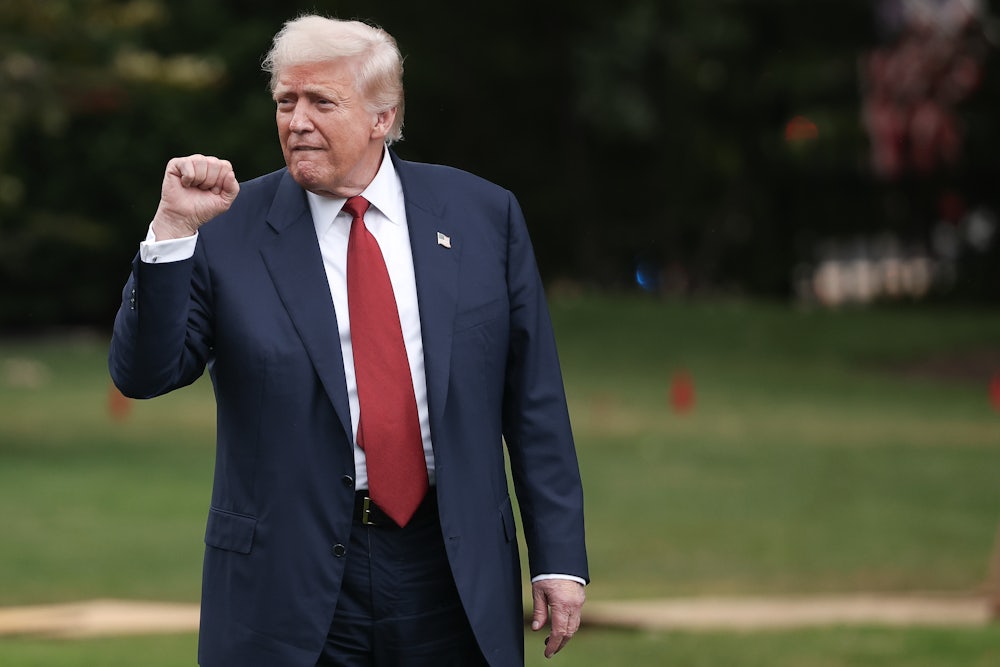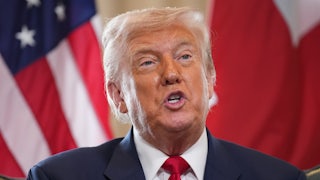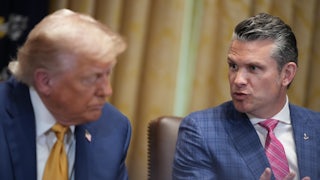The New York Times remains, by any measure, our greatest newspaper. As much as liberals complain about the way it covers Donald Trump—which I did pretty aggressively during last year’s campaign—it still behooves us to remember that a lot of what we know about the bad stuff Trump has done, we know from the Times. So the scoops division of the paper is working more or less as it should, and we should all be glad for that.
However, it’s in the way the paper chooses to explain and interpret our nation’s politics that it so often falters. The excess of caution, the relentless urge to be “fair,” the no-doubt painstaking search for the perfect headline word that will appear objective.… Oy, those headlines. “Trump, Claiming Weak Jobs Numbers Were ‘Rigged,’ Fires Labor Official.” Really? “Claiming”? Without mentioning that Trump offered no evidence to support this “claim”? I suppose it may be too much to ask the Times’ editors to emphasize what a brazenly corrupt move this was (although it shouldn’t be!), but surely they could at least sneak in the fact that Trump’s claim was backed by no evidence whatsoever.
All of which brings me to a piece of “news analysis” that ran Sunday about tariffs. The headline was “Trump’s Tariffs Are Making Money. That May Make Them Hard to Quit.” Under it, Andrew Duehren reported that tariffs “have already started to generate a significant amount of money for the federal government, a new source of revenue for a heavily indebted nation that American policymakers may start to rely on.”
Hmm. OK. Interesting, maybe. But what are the numbers? Well, it turns out that so far this year, through July, customs duties and excise taxes have brought in $152 billion, roughly double the $78 billion during the same period last year.
Double! That’s a lot! It seems to lend credence to Trump’s claims that his tariffs will generate so much revenue that we won’t know what to do with the money, and he’ll be able to eliminate the IRS, a claim he’s made many times. So gosh, maybe Trump really was right about this.
Uh, no. Here are a few facts and figures, none of which appear in the article. Federal revenue from all sources in recent years has been around $4.7 trillion (it varies from year to year depending on the strength of the economy). Typically, customs fees account for about 2 percent of that revenue. Commit that to memory, please: 2 percent. So that even if tariff revenue doubles, it will account for 4 percent of all federal revenue. It could double again—which, incidentally, would mean tariffs so high as to stifle much international trade—and still account for only 8 percent of all federal revenue.
So where does federal revenue come from? About half—that is, around $2.4 trillion or so—comes from the personal income tax. Another third, or roughly $1.6 trillion, comes from payroll taxes. And then about 10 percent, or just under $500 billion, comes from corporate taxes. I know all these numbers off the top of my head, and if I know them, the guy who covers tax policy from Washington for The New York Times ought to know them too. Maybe he does, which would make his decision not to include them in a piece like this all the more bewildering because they provide vital context. But all Duehren has to say on this point is that “income and payroll taxes remain by far the most important sources of government revenue.”
That’s a very vague and fuzzy way of putting it. It obscures reality and gives no sense of the scale of what a laughably tiny amount of money Trump’s doubling of tariff revenue amounts to. A billion here, a trillion there; people don’t know the difference. If a reader bothers to stop and think about it, she might think that a trillion is what, 10 times larger than a billion, kind of like 1,000 to 100? No. A trillion is one thousand times larger than a billion. So the idea that this new tariff revenue is remotely meaningful next to the revenue taken in from income and payroll taxes is absurd. It would be as if the Times’ culture desk noticed that Yanni had suddenly doubled his sales in 2025 and ran a story saying hey, Taylor Swift, lookout!
Also absurd is Trump’s claim that he can get rid of the IRS someday. For that to happen, Trump would need to somehow generate eight times as much revenue from tariffs as he is now. Tariffs will never generate that kind of income. And besides, a tariff regime that brought in as much money as even the payroll tax would stop international trade cold and destroy the global economy. On top of all that, there’s the widely held concern that these tariffs are going to raise prices and hurt the economy—in one recent poll, nearly eight in 10 Americans, including 70 percent of Republicans, think the tariffs will raise prices.
The premise of the New York Times article is that the $152 billion figure, which of course will be around $300 billion by year’s end if things keep pace, has some people thinking that maybe tariff revenue will be substantial enough that even a Democratic president might be loath to give it up. Really? I would certainly hope that any Democratic president would rather just rescind Trump’s tax cuts. Those are costing the Treasury around $400 billion a year. It’ll be a test of Democrats’ mettle, once they’re in power again, to see if they’ll choose the wiser course of paring back Trump’s tariffs and raising taxes on the rich. And it practically goes without saying that when that day comes, Republicans will suddenly start caring about deficits again—the deficits they, as usual, created.
The article does have a couple of redeeming qualities. It notes that a shift from taxing earnings to taxing goods will be regressive. And it does quote a couple of liberals as the skunks at this picnic. Ernie Tedeschi of the Yale Budget Lab avers that “there are more efficient ways” to raise revenue, and Alex Jacquez of the Groundwork Collaborative sneaks in, in the piece’s very last paragraph, to say it more bluntly: “This is clearly not an efficient way to gather revenue.” So that viewpoint is represented.
But the piece is framed in a way that will suggest to the average reader that Trump is onto something, that he’s delivering. And it’s a subtle but constant thing, not only in the Times’ interpretive pieces but across the mainstream media: Things Trump does that are obviously corrupt or brazen are “controversial” or “debatable”; autocratic steps taken against political foes are “aggressive”; locking up innocent people and defying judicial orders aren’t direct assaults on the Constitution but rather “highly unusual” assertions of executive power. It happens every day, and it can’t help but have the effect of normalizing behavior that if it continues will result in the end of American democracy.
It’s not enough for the nation’s most important newspaper to chronicle democracy’s decline. It must, at some point, affirmatively oppose it. Without democracy, after all, there will be no New York Times, in any meaningful sense. That can’t be the world the Times wants.



